| Inheritance system | ||||
| Genetic | Cultural | |||
| Trait bearers | Individual |
Modern synthesis
1
|
Extended inheritance
2
|
|
| Artefact |
Extended phenotype
3
|
Memetics
4
|
||
| Group |
Group selection
5
|
Cultural group selection
6
|
||
Select a work or theory to display information here
Individuals are biological organisms that reproduce sexually or asexually. There is plenty of controversy over the definition of "biological individual", but the paradigm cases are clear enough.
Artefacts are objects created by biological organisms. Examples include human tools, birds' nests, beaver dams, stones used by monkeys to crush nuts, and many more. For our purposes this category includes abstract objects such as information learned during an organism's lifetime (i.e. information that is not innate).
Groups are collections of individuals.
Genes are portions of DNA transmitted in reproduction. They are causally responsible for aspects of an organism's development and account for some of the similarity between parents and offspring.
Cultural inheritance refers to any mechanism by which information is transmitted socially. Examples include imitation, emulation, and explicit teaching.
The modern synthesis justifies explanations of the morphology and behaviour of individuals in terms of selection acting on genes.
The modern synthesis is the 'standard' theory of evolution at the heart of contemporary biology. It combines Darwin's theory of natural selection, which sought to explain the adaptive forms and behaviours of individual organisms, with twentieth-century discoveries in genetics.
Strictly, the modern synthesis encompasses more than just selection. While selection accounts for gene frequency change in terms of the adaptive benefits different genes enable, the theory discusses other processes of genetic change such as drift, which accounts for frequency change due to random chance.
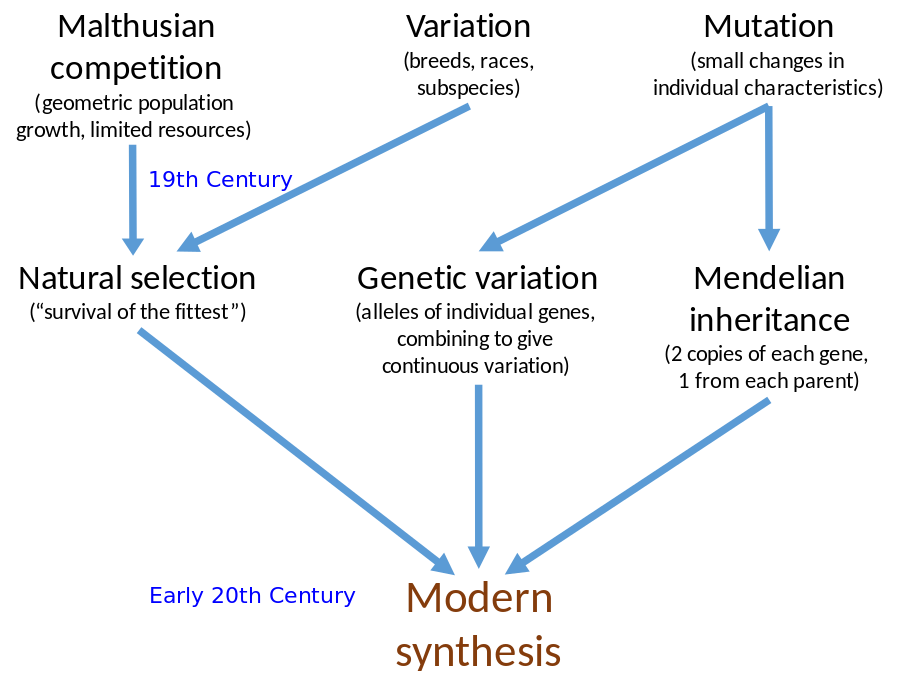
Historical developments leading to the modern synthesis (Wikipedia)
See also:
- Modern Synthesis (Wikipedia)
- Neo-Darwinism (Wikipedia), a broader term encompassing any theory that links natural selection with genetic inheritance.
Extended inheritance refers to the transmission of individual traits -- typically social behaviour -- via cultural mechanisms such as imitative learning.
Animals whose behaviour is not entirely determined by their genes sometimes learn behaviour by observing conspecifics. When transmission of behaviour repeats over many generations, it can give rise to evolutionary patterns distinct from those associated with genetic evolution.
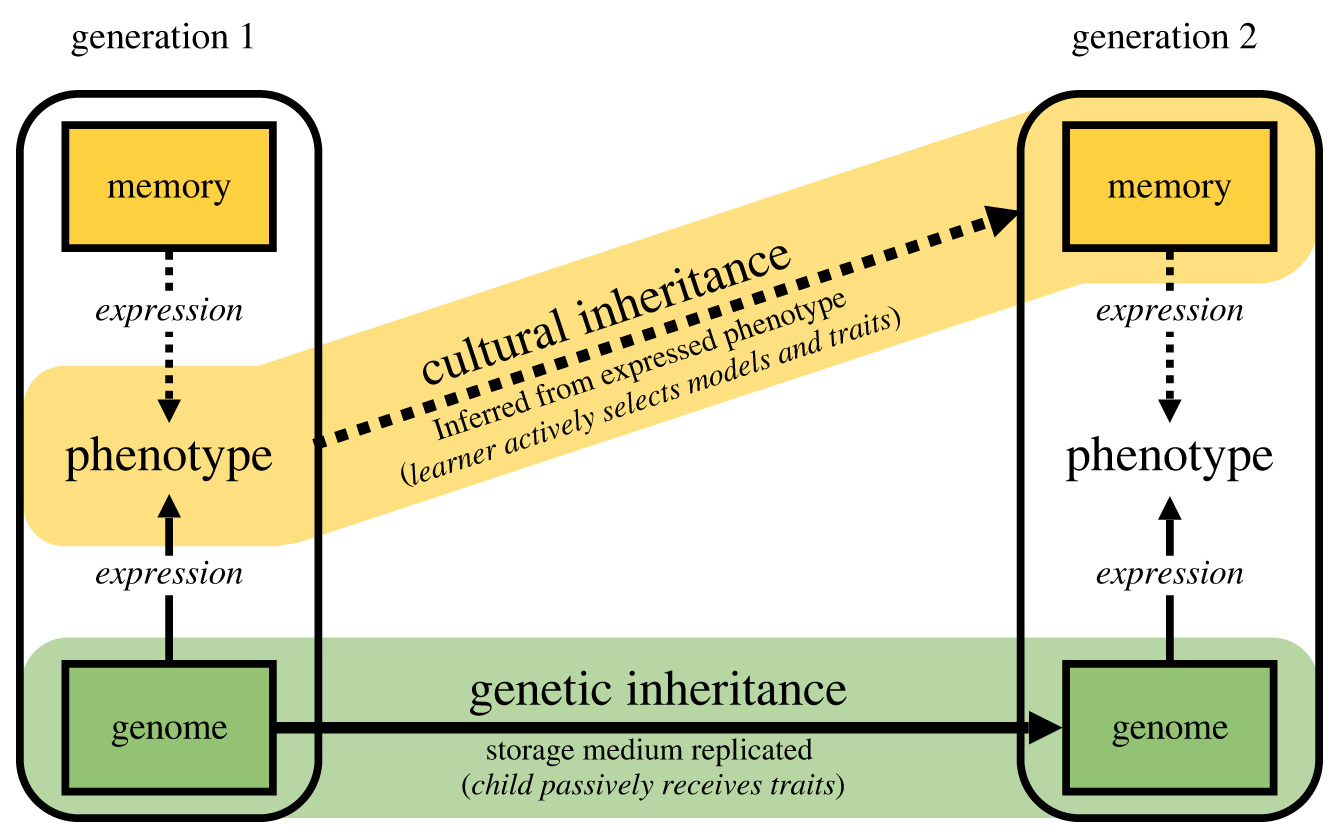
A model of the relationship between cultural inheritance and genetic inheritance. From Waring & Wood (2021).
The vast majority of work on extended inheritance focuses on human societies. See also:
The term extended phenotype refers to an expansion of the modern synthesis to include artefacts created by organisms, explaining their form and change over time by appealing to natural selection acting on genes.
For example, just as a bird is built by genes subject to natural selection, so a bird's nest is 'built' by those same genes via the intermediary of the bird itself. Adaptive features of the nest can therefore be explained by reference to natural selection, just like adaptive features of individual organisms.
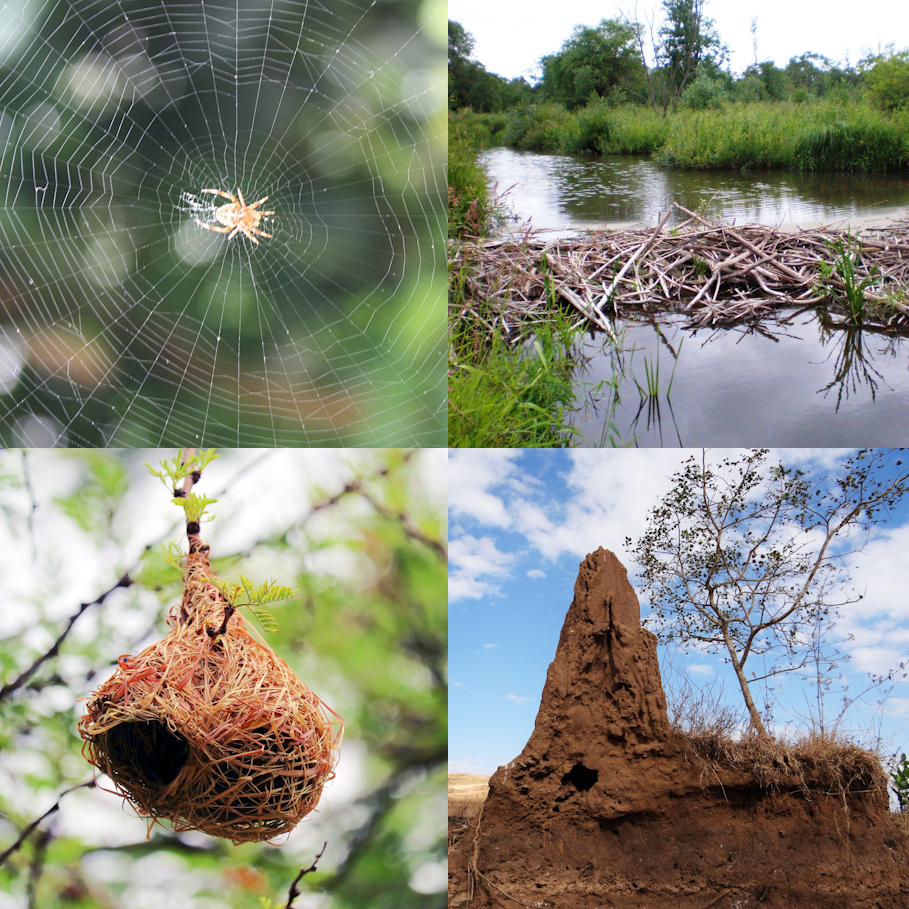
Four canonical examples of extended phenotypic traits (clockwise from top left): A spider's web (Wikipedia), a beaver dam (Wikipedia), a termite mound (Wikipedia), a Weaver bird's nest (Wikipedia).
The theory was introduced by Richard Dawkins his 1982 book of the same name. See also:
Memetics explains how artefacts change over time by appealing to cultural selection. A set of artefacts can be considered an evolving population, whose environment is constituted by a population of individuals. Artefacts are more successful when individuals find them useful, entertaining, or otherwise worth keeping and copying.
The term 'meme', coined by Richard Dawkins in The Selfish Gene, refers to artefacts and ideas considered from the perspective of cultural selection.
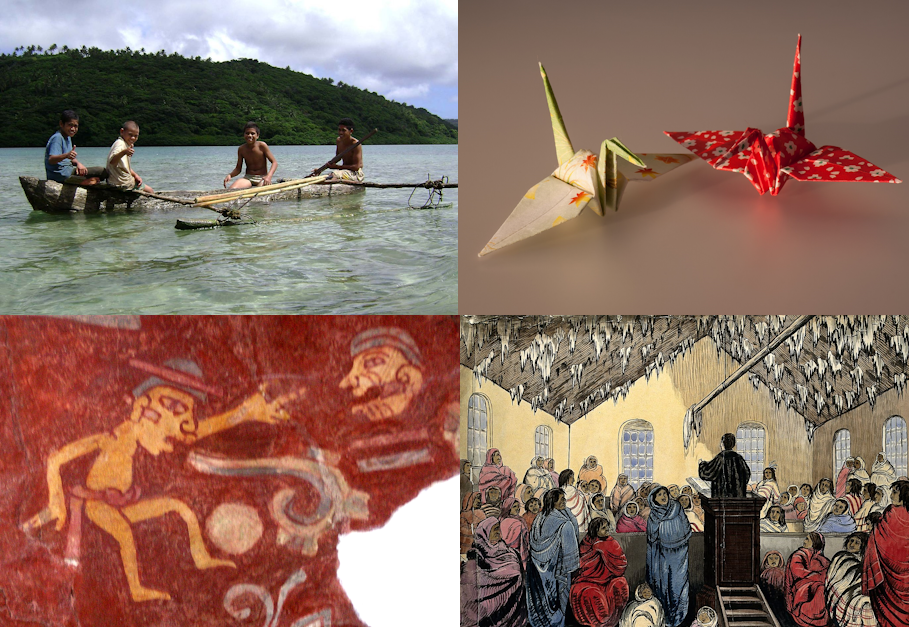
Four putative examples of memes (clockwise from top left): A Polynesian outrigger canoe (Wikipedia), origami constructions (Wikipedia), religious belief (Wikimedia commons) and natural language (Wikipedia).
Memes can include physical objects or the recipes for constructing them, such as outrigger canoes and origami patterns. Memes also include patterns of behaviour, perhaps even as complex as natural language and religious belief. In each case, something about the artefact, idea, or behaviour leads to it being passed on to more people, thus promulgating the meme. Physical artefacts can differ in performance (canoes) or aesthetic quality (origami), leading some variants to be more likely to be constructed in future. Behaviours can be more or less transmissible for a wide variety of reasons. Linguists study why certain language forms are transmitted and others are lost. Religions that emphasise proselytism and tithing to support missionary work may be more liable to grow faster than more insular faiths. Individuals need not choose items consciously. Ideas, behaviours or patterns of speech might get passed on "under the radar", so to speak.
See also:
The view of natural selection as 'survival of the fittest' -- implying the success of individualistic and uncooperative behaviour -- has long been at odds with observations of widespread cooperation in nature. Group selection is a mechanism proposed to account for this discrepancy. The idea is that genes promoting cooperation between members of a group will lead to greater success for the group overall, and thus greater success for each individual within it. The theory explains group traits by appeal to selection on genes.
However, the vast majority of evolutionary biologists do not take group selection to plausibly occur in nature. Rather, many of the things group selection purports to explain are better explained by kin selection, an existing component of the modern synthesis. Debate between advocates of group selection and kin selection rose to prominence in the 1960s, and continues to some extent today.
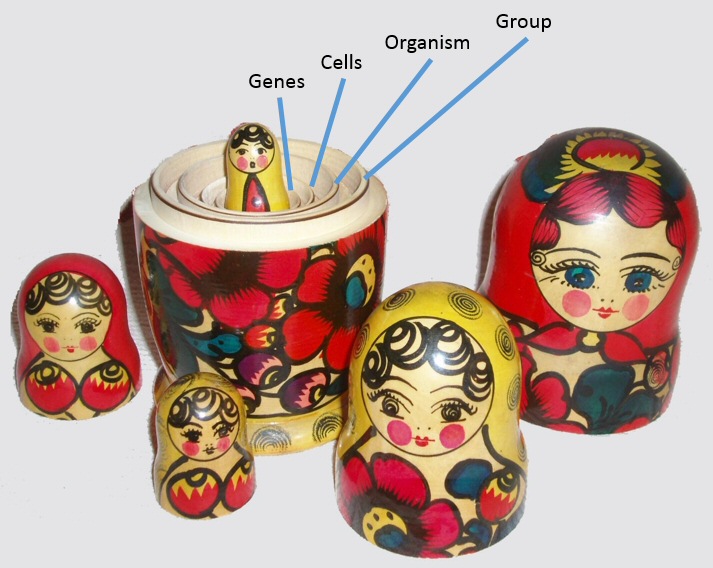
Proponents of group selection have used the analogy with Russian nesting dolls to portray the group as a natural level of organisation above the organism, just as the organism is a collection of cells, and cells are collections of genes (Wikimedia Commons)
See also:
- Wikipedia
- The 2010 back-and-forth in Nature between group selectionists and kin selectionists over the evolution of eusociality.
Cultural group selection explains group traits by appeal to selection acting on cultural inheritance.
Cultural group selection explains the proliferation of behaviours due to the benefits they afford to the groups in which they appear. The theory typically focuses on traits that enhance group cohesion, such as conformity and participation in social activities, as well as traits that enhance the transmission of social behaviour, such as teaching and learning.
The term "cultural group" can have a few different meanings, so we should be careful about how it is used in this theory. As used here, a cultural group is any collection of individuals that share culturally transmitted traits. The definition is quite flexible: how many culturally transmitted traits must a group share before it becomes a cultural group?
Since cultural group selection was originally proposed to explain features of human sociality, the traits in question typically form robust clusters that are shared between all or most humans in a group (e.g. ritual practices, language or dialect, beliefs, and norms). This doesn't preclude other animals from forming cultural groups -- perhaps groups of humpback whales that share a song pattern could be considered a cultural group in the strict sense -- but the power of the theory to explain behaviour in those cases is weaker, because only one cultural trait is shared rather than a suite of socially relevant activities. It's not clear whether a single group trait like a song pattern could generate the kind of inter-group variation required for cultural group selection to occur.
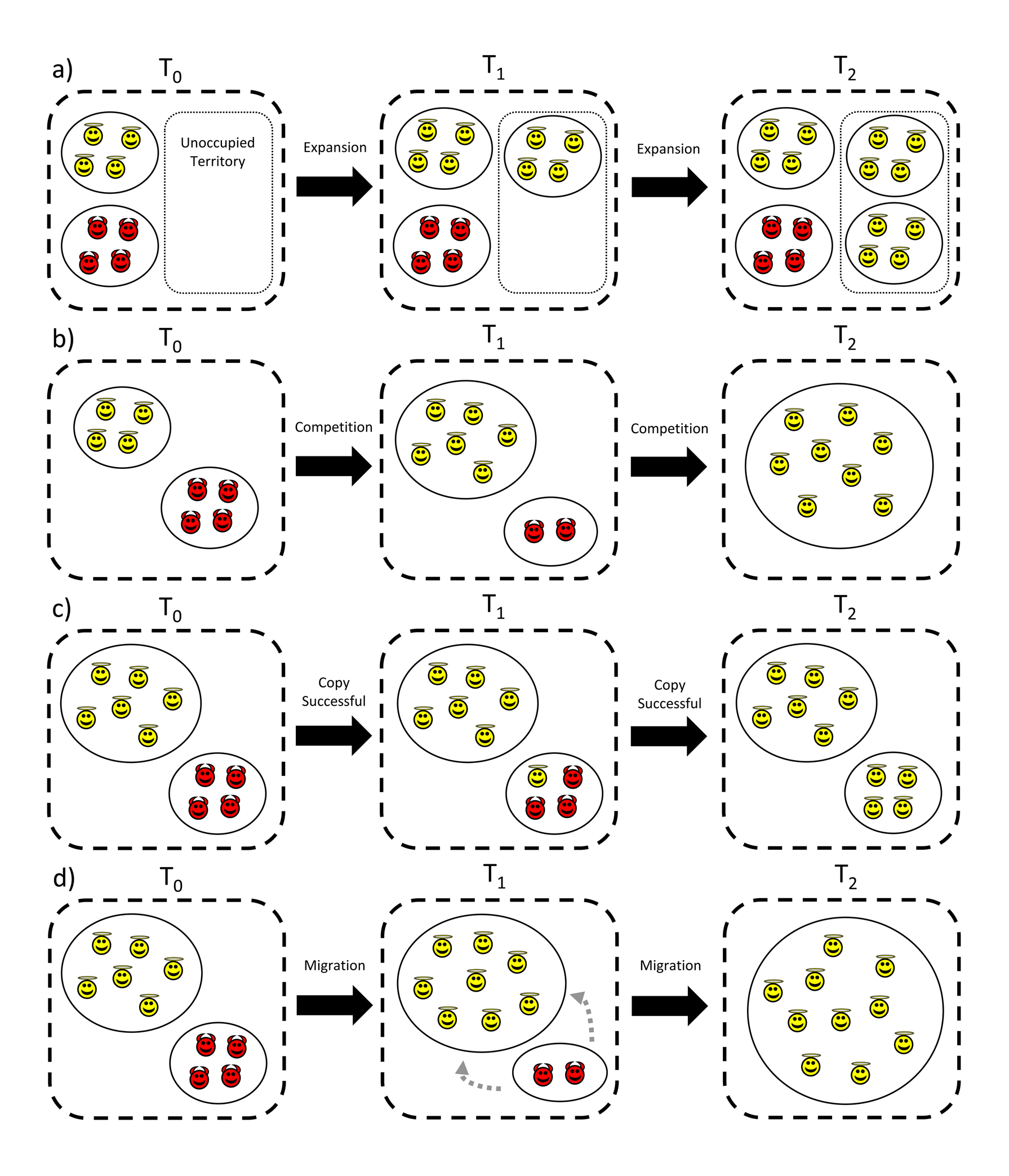
In a critical review, Smith (2020) describes four distinct mechanisms of cultural group selection. In each case a group containing a cooperative cultural variant (angel icons) 'outcompetes' a group containing an uncooperative cultural variant (devil icons), but the explanation for how this occurs is different.
See also:
- Wikipedia
- Cultural group selection and human cooperation: a conceptual and empirical review (2020) by Daniel Smith